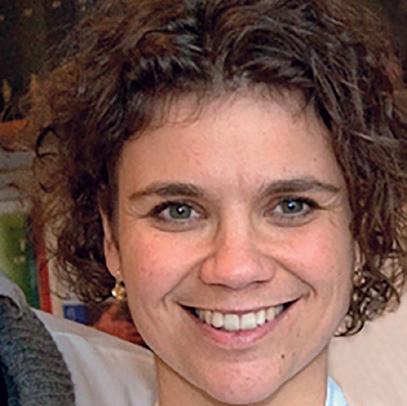
5 minute read
Low prevalence of patients diagnosed with psoriasis in Nuuk: a call for increased awareness of chronic skin disease in
This study set out to estimate the age- and gender-specific prevalence of psoriasis in Nuuk, Greenland. No overall gender-specific difference in prevalence was observed. Further, the study showed a low prevalence of patients diagnosed with psoriasis in Nuuk. However, we speculate that the prevalence found in this study is underestimated, and further research should be conducted.
SOFIA HEDVIG CHRISTENSEN BOTVID is MD, currently a Ph.D. student at National Research Center for Allergy as part of the Department of Allergy, Dermatology, and Venereology at Gentofte Hospital, Denmark. She has recently finished working as a doctor in Nuuk and Paamiut, Greenland, for 15 months. CARSTEN SAUER MIKKELSEN is MD and specialist in dermato-venereology. He is a private practitioner in Brønderslev and is part of the research unit at the Department of Dermatology, Aalborg University Hospital, Denmark. Greenland is the largest island in the world, with 85% of its 2.2 million square kilometers covered by ice. Approximately 56,500 people live along the ice-free coastline in Greenland, of which 19,261 live in the capital, Nuuk. The majority of the population is of Greenlandic origin (90%). 10% are immigrants, mostly from Denmark, but also including 2.4% from the Philippines, Thailand, and Iceland.1
Psoriasis around the world
Psoriasis is a multifactorial polygenic chronic, immune-mediated inflammatory skin disease characterized by the formation of sharply demarcated, scaly erythematous plaques.2 Psoriasis is estimated to affect 125 million people worldwide. In Europe, it is estimated that approximately 5 million people suffer from psoriasis, while 7 million people in the US have psoriasis.
In western countries, the prevalence of psoriasis is believed to be around 2–4%,3-5 while the highest prevalence of psoriasis is found in the Scandinavian population. In Denmark, approximately 2.2–2.8% of the population suffer from psoriasis.6,7 The self-reported lifetime prevalence of psoriasis in northern Norway increased from 4.8% in 1979–1980 to 11.4% in 2007–2008, indicating an increased awareness of the disease over the last 40 years.8 Due to difficulties in accurately identifying and documenting the disease, psoriasis is believed to be underdiagnosed and undertreated in many countries around the world.5
Psoriasis in Inuit populations
Very few studies describe the prevalence and incidence of psoriasis among Inuit populations.9-11 Higher prevalence rates have been reported at
CONCLUSION: High prevalence rates of psoriasis have previously been reported among Inuit populations. However, this study found a low number of patients diagnosed with psoriasis in Nuuk, Greenland. Furthermore, no overall gender-specific difference was observed. Hence, we suggest that the prevalence found in this study is underestimated, and further research should be conducted.
higher latitudes, and also in Caucasians compared with other ethnic groups.12 In Greenland, the earliest mention of psoriasis stems from a book from 1940 based on observations done over 30 years by a doctor.10 Here, a girl in 1912 was described as having psoriasis. Furthermore, an epidemiological study from 1980 found a low incidence of chronic diseases, including psoriasis, in the Upernavik district in northern Greenland in the years of 1950-1974.11 The current prevalence of psoriasis in Greenland is unknown.
The objective of this study was to estimate the age- and gender-specific prevalence of psoriasis in Nuuk. Furthermore, we aimed to explore the common risk factors and co-morbidities for patients with psoriasis compared to an age- and gender-matched control group. The study was designed as a cross-sectional case-control study based on national high-quality data from medical records and population registers in Nuuk, from January 1, 2021, to January 1, 2022. Results
During the study period of 12 months, 175 patients (0.9%) were diagnosed with psoriasis in Nuuk, of which 79 (45%) were females and 96 (55%) were males. The prevalence of patients diagnosed with psoriasis in the adult population aged 20 years old or more in Nuuk was 1.1%. No overall gender-specific difference in prevalence was observed.
Chronic diseases including diabetes, hypertension, and obstructive lung disease were observed more frequently among patients with diagnosed psoriasis (28.6%) in Nuuk compared to controls (20.9%) (p < 0.05).
We found a low prevalence of patients with psoriasis in Nuuk. We speculate that the prevalence found in this study is underestimated. Thus, we call for an increased awareness of chronic skin disease in Nuuk, Greenland, particularly since chronic co-morbidity to psoriasis was common.
ORIGINAL PUBLICATION: Botvid SHC, Hove LS, Backe MB, Skovgaard N, Pedersen ML, Mikkelsen CS. Low prevalence of patients diagnosed with psoriasis in Nuuk: a call for increased awareness of chronic skin disease in Greenland, Int. Journal of Circumpolar Health. 2022.81:1. DOI: 10.1080/22423982.2022.2068111
References:
1. Grønlands Statistik. [Online]. [cited 6 Mar 2022]. Available from: https://stat.gl/default.asp?lang=da. 2. Parisi R, Symmons DPM, Griffiths CEM, et al. Global epidemiology of psoriasis: a systematic review of incidence and prevalence. J Invest Dermatol. 2013;133(2): 377–5. 3. Stern RS, Nijsten T, Feldman SR, et al. Psoriasis is common, carries a substantial burden even when not extensive, and is associated with widespread treatment dissatisfaction. J Investig Dermatol Symp Proc. 2004;9(2): 136–139. 4. Gelfand JM, Weinstein R, Porter SB, et al. Prevalence and treatment of psoriasis in the UK: a population-based study. Arch Dermatol. 2005;141(12): 1537–1541. 5. Kurd SK, Gelfand JM. The prevalence of previously diagnosed and undiagnosed psoriasis in US adults: results from NHANES 2003-2004. J Am Acad Dermatol. 2009;60(2): 218-224. 6. Lomholt G. Prevalence of skin diseases in a population: A census study from The Faroe Islands. Dan Med Bull. 1964; 11:1–7. 7. Egeberg A, Skov L, Gislason GH, et al. Incidence and prevalence of psoriasis in Denmark. Acta Derm Venereol. 2017;97(7): 808–812. 8. Danielsen K, Olsen AO, Wilsgaard T, et al. Is the prevalence of psoriasis increasing? A 30-year follow-up of a population-based cohort. Br J Dermatol. 2013 Jun;168(6): 1303-1310. 9. Harvald B. Genetic epidemiology of Greenland. Clin Genet. 1989;36(5): 364-367. 10. Connor WE. Effects of omega-3 fatty acids in hypertriglyceridemic states. Semin Thromb Hemost. 1988;14(3): 271-284. 11. Kromann N, Green A. Epidemiological studies in the Upernavik district, Greenland: incidence of some chronic diseases 1950–1974. Acta Med Scand. 1980;208(1–6): 401-406. 12. Farber EM, Nall ML. The natural history of psoriasis in 5,600 patients. Dermatology. 1974;148(1): 1-18.










